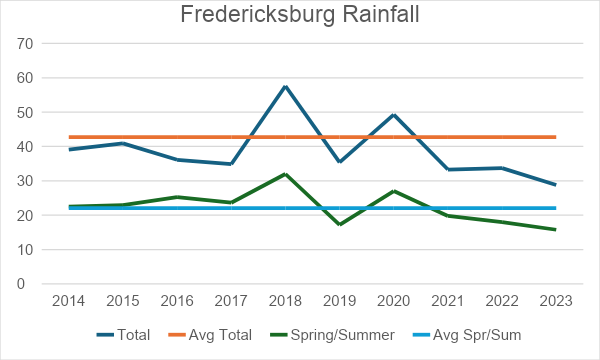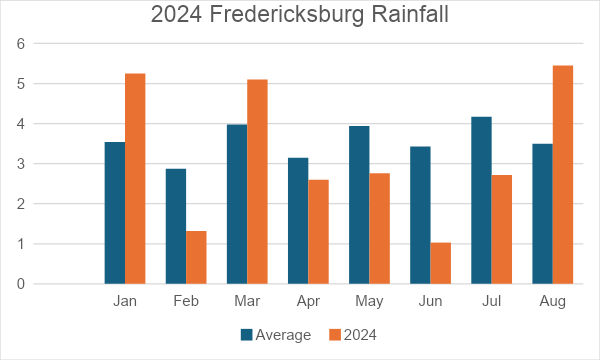Environmental Cents: How Dry has it Been?
Bruce Saller looks into how this year's rainfall compares to previous years.
By Bruce Saller
CONTRIBUTOR
Up through early August, our area was rated as either “abnormally dry or in “moderate or severe drought.” (The rainfall from Tropical Depression Debby and the recent thunderstorm improved Virginia’s drought condition.)
The University of Mary Washington’s weather station has a record of daily weather for many years. I have plotted the last ten years of rainfall, and the rainfall during the growing season (April through September) against their respective average rainfalls.
From 2014-2017, even though the annual rainfall was below average, the spring/summer rainfall was above average, which benefited area farmers and gardeners and kept us out of a drought condition.
Since 2021, both the annual rainfall and the spring/summer rainfall have been below average, with the spring/summer rainfall decreasing each year.
2024 started with a wetter than average winter, followed by a dry spring and summer through July. On July 30, the U.S. Department of Agriculture declared that farmers in thirty localities (including Stafford) were eligible for drought emergency assistance.
August was wetter than average, but 88% of the rainfall was due to two events: Tropical Depression Debby and the 8/29 thunderstorm. While the rainfall was welcome, heavy rains can cause crop damage, soil erosion, and flooding, and can impair water quality as pollutants deposited on land wash into water bodies.
It is too soon to tell if our recent dryer conditions are a temporary aberration or part of a longer cycle due to our changing climate, but we should start making changes now to reduce our water usage in case the situation worsens. Here are some things you can do to reduce your long-term water usage:
Select water efficient washing machines and dishwashers
Plant native and drought resistant plants, trees, and shrubs
Plant more perennials than annuals. Perennial’s deep roots require less water and they store carbon in the plants roots, stems and leaves, reducing your carbon footprint. Annuals tend to add to your footprint since they need more fertilizer and water, and don’t store carbon in the soil due to their short roots and lifespan.
Plants, especially potted plants, dry out faster in the sun than in the shade, so put them in areas where they are getting the lower end of required sunlight.
“Full sun” means at least 6 hours/day, but some plants such as vegetables need 8-10 hours/day.
“Partial sun” or “partial shade” means that the plant needs 3-6 hours of direct sun per day.
Plants getting morning sun will use less water than those in the stronger afternoon sun.
The National Weather Service is predicting that our area will experience a warmer and wetter than average fall. Hopefully, their prediction will be accurate.
Local Obituaries
To view local obituaries or to send a note to family and loved ones, please visit our website at the link that follows.
Support Award-winning, Locally Focused Journalism
The FXBG Advance cuts through the talking points to deliver both incisive and informative news about the issues, people, and organizations that daily affect your life. And we do it in a multi-partisan format that has no equal in this region. Over the past month, our reporting was:
First to report on a Spotsylvania School teacher arrested for bringing drugs onto campus.
First to report on new facility fees leveled by MWHC on patient bills.
First to detail controversial traffic numbers submitted by Stafford staff on the Buc-ee’s project
Provided extensive coverage of the cellphone bans that are sweeping local school districts.
And so much more, like Clay Jones, Drew Gallagher, Hank Silverberg, and more.
For just $8 a month, you can help support top-flight journalism that puts people over policies.
Your contributions 100% support our journalists.
Help us as we continue to grow!














Hey Bruce, If we switch from AC units to heat pumps for our house in Idlewild, do we also need to replace the furnace, or will the heat pump be sufficient for both heating and cooling in Fredericksburg? And is there anything in building codes or insurance requirements that you have a furnace along with your heat pump? Hope you can help with this. Thanks.